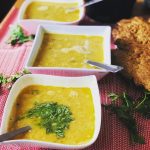Back in the 1970’s, you really did not hear much about Moroccan food, and we didn’t know what we were missing. This beautifully spiced and exotic dish is a dinner party winner, can be prepared in advance and is so full of flavour.
Tagines, or tajines is not the actual name of the food, it is the dish in which it is cooked – another thing I learned. Today, every market and souk is full of the tagine pots which are made from clay, and the brightly decorated glazed or unglazed dishes are everywhere. The conical lid is almost a trademark of this attractive pot.
I flew into Rabat, the capital, as there was no airport at my final destination, Marrakech, which is where everyone told me to go to. You could spend days just wandering around the main square, Jema el Fnaa, with its intriguing stalls selling everything from clothes, traditional Moroccan slippers, huge ‘buy as much as you like’ local spices and, of course, the clay tagine pots. There were also street food stalls and restaurants dotted around – and my nemesis – snake charmers! Moroccan coffee was another experience to try – thick and syrupy and strong. Served with a glass of water, which you really needed!
Morocco is a country that is relatively self-supporting, and what you cannot get that is grown there, they import from Spain. As well as vegetables, meat and fish, grains can accompany many dishes, even though only 2 percent of the land is suitable for cultivating grains.
Oranges, lemons, apricots (quite often preserved) are abundant, as are strong flavoured greens, potatoes and sweet potatoes. Pulses such as chickpeas are also frequently used, but having said that, if you watch the Moroccan people eating a tagine dish, it is normally with flatbread, to scoop up the juices from the meal. This bread is locally known as khabz’ and resembles a pitta bread, but much softer. One trader showed me how to make a khabz, and I still use the recipe today.
The spices
Before I sat down for a taste of my first authentic tagine, I wandered around the market square to see the array of spices on offer – I was astounded at how many there were and I didn’t know all of the names. Some stalls had the names in English, but others did not – so it was very much a ‘that looks like cinnamon’ kind of experience. I was only in Morocco for three days, so I decided to use a guide, and that turned out to be the best idea. He took me to other places away from the main square, where prices were cheaper but still with a great selection.
 |
Do you love chickpea as much as us? Try this Turmeric, Chicken and Chickpea soup recipe here! |
Waiting until my last morning (the market opened once the first call to prayer by the muezzin and until very late at night), I purchased literally heaps of spices in huge plastic bags, so I had to buy another suitcase in the market! I was spoilt for choice, but brought back Ras al Hanout (traditional Moroccan spice), saffron, cumin, anise seed and some beautiful plump olives steeped in harissa. I could not resist both their olive oil and their argan oil. Youssef, my guide, told me that his wife used argan oil to cook, but also to put on her face and use as a conditioner for her hair!
Our memorable lunch
In Marrakech these days, there are plenty of traditional cooking schools that serve meals and takeaways – these places are the real roots of Moroccan food, cooked and served by women as a non-profit organisation. Any money taken is used to provide food for the poor of Marrakech. You can join in with the classes or simply eat there!
I was concerned that maybe things would be too hot or too spicy, but the subtleness of the flavourings was on point. With a blend of sweet and sour, fruitiness and light spicing, my lamb tagine was perfection. The lamb melted in my mouth, the vegetables and fruit additions still had texture – quite surprising for the length of time the dish is cooked for (up to 4 hours). Bread was perfect – for me, better than couscous to eat with the tagine.
We finished with some sweet apricot pastries – again, light and fluffy with delightfully sweet apricots and sultanas (or were they raisins, I can’t really remember!).
I can only say ‘go to Morocco’. Yes, it is touristy, but it is an experience you will never forget. Steeped in culinary history, it is a must. I did not have time for the sights, nor a trip into the desert under the stars, but I will next time!


Want to comment?
Sign in or Register